COOPERATION MODEL
ARTIFICIAL INTELLIGENCE
PRODUCT ENGINEERING
DevOps & Cloud
LOW-CODE/NO-CODE DEVELOPMENT
INDUSTRY
FRONTEND DEVELOPMENT
CLOUD DEVELOPMENT
MOBILE APP DEVELOPMENT
LOW CODE/ NO CODE DEVELOPMENT
EMERGING TECHNOLOGIES







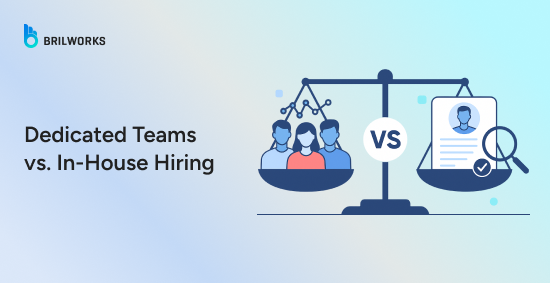
Hiring is a fundamental business activity that needs constant attention and alignment. For many companies, hiring in-house has been challenging. In fact, 69% of hiring managers struggle to find qualified candidates, as stated in the report by the Manpower Group. Yet, this is a default model for more than 72% of companies.
However, it is no longer the norm. The dedicated model is also picking up. It appears as a compelling alternative to many founders, enabling them to opt for a full-time external team that works exclusively for them.
But again, it's not always the best fit. While a dedicated development team may solve scaling and delivery gaps, a high-regulation industry may still need the IP security of in-house control.
In this guide, we will break down the differences between in-house hiring and dedicated teams.
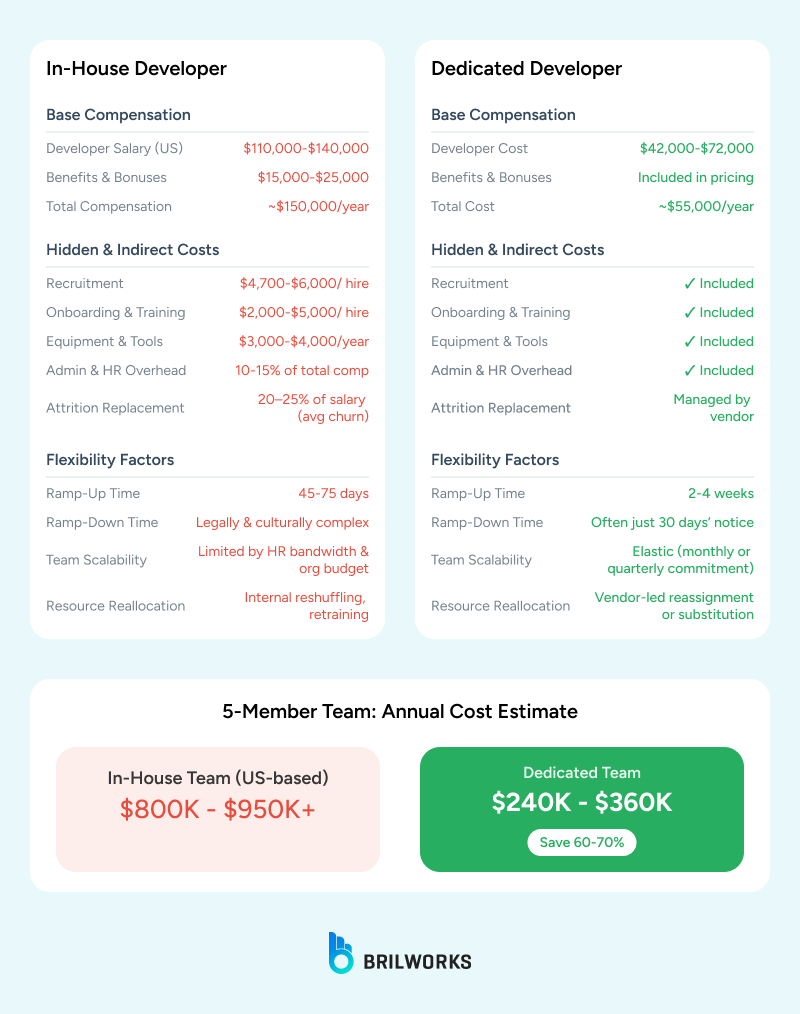
A dedicated team is a group of full-time professionals provided by a service partner to work only on your company's project. Unlike traditional outsourcing, these teams are not shared across clients or switched between tasks.
This model helps companies build software faster without going through long recruitment cycles. Most dedicated teams include vetted developers. With this model, you get pre-vetted experts, often within a few weeks, and they work as part of your team.
The service provider handles team assembly, infrastructure, and HR responsibilities. You decide the direction of the project, what gets built, which features go next, and how timelines are set. The team delivers those outcomes while blending into your daily processes, just like an internal team would.
Teams can be based anywhere, onshore, nearshore, or offshore. Many businesses in North America and Europe choose partners in India or Eastern Europe because of the strong engineering talent and cost savings. But location matters less than the team's ability to integrate well. A strong provider will match your working hours and adapt to your tools, regardless of where the team sits.
It's easy to confuse dedicated teams with staff augmentation, but the structure is different.
With staff augmentation, you usually bring in individual engineers to support your internal team for a limited time. You manage everything, and the person is just filling a gap.
With dedicated hiring, you're getting a long-term team that acts more like a direct extension of your company.
In-house hiring means building and managing your own team of full-time employees within your company. These team members are on your payroll, follow your internal policies, and typically work from your physical or virtual office. You own the recruitment, training, retention, and all day-to-day operations. This approach is still the default for many businesses.
It requires a significant investment in time and budget. On average, it takes 35–45 days to fill a technical role. For niche roles, timelines often stretch beyond 60 days.
Deep product knowledge
Full access and control
Cultural alignment
This is why many startups prefer to hire internally for their founding product team.
In-house hiring also brings cost and complexity:
Salaries for skilled developers are rising. As of 2025, a mid-level ReactJS developer in the U.S. earns around $110,000 to $140,000 per year, while Node.js developers with backend expertise are in similar demand (ZipRecruiter).
You'll need to budget for benefits, equipment, training, and retention.
High turnover in tech roles is a risk.
According to Mercer's Talent Trends report, over 30% of developers consider switching jobs every 12–18 months.
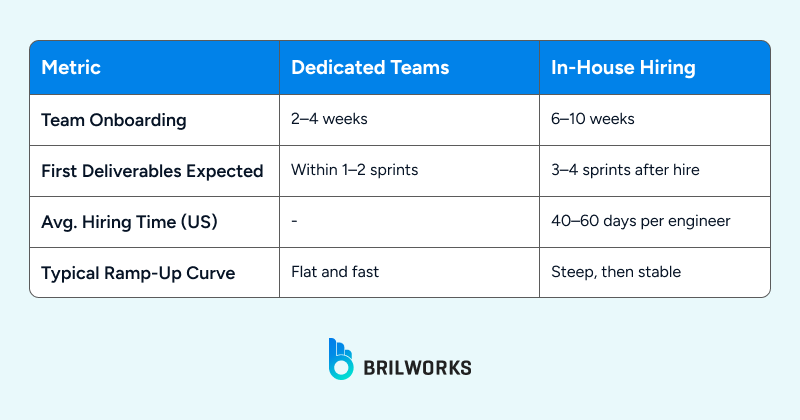
Businesses rarely debate whether to build software. The real decision is how to build it, internally, externally, or somewhere in between. T
Hiring a Node.js developer in-house may seem the right path. But once you account for recruitment, onboarding, training, retention bonuses, and equipment, the total cost escalates. Dedicated teams avoid this hidden load.
You're not locked into long-term costs. Providers cover everything from infrastructure to HR, which is why dedicated hiring often results in more predictable monthly burn. That doesn't mean it's always cheaper. But it's leaner, faster to adjust, and easier to manage when your roadmap changes.
A well-run HR process takes weeks. In competitive regions, it can take 45–75 days to onboard the right developer. Dedicated teams shorten this gap. Because providers maintain ready-to-deploy talent pools.
The ability to scale your team is the major advantage of dedicated hiring. You can adjust your team size based on features, milestones, or user growth. In-house hiring can't match that.
One of the biggest strengths of dedicated hiring is how fast execution starts. You're handed a team, often in under 3 weeks. That's a big reason why product-led companies in competitive markets lean on dedicated team structures for execution.
In contrast, in-house hiring requires patience. While this slows initial delivery, it does lead to a better long-term rhythm. Once an internal team is fully formed, you get deeper product familiarity, better collaboration and ownership, especially for companies building IP-heavy platforms or complex enterprise software.
Dedicated hiring is more affordable, especially when sourcing offshore or nearshore. You aren't dealing with multi-month recruitment cycles, costly attrition, or expensive retention plans. Instead, you get flat-rate predictability, even when market rates shift.
According to Accelerance's 2025 Global Talent Report, companies using dedicated offshore teams can save between 40–60% on total development costs.
Most dedicated teams are assembled from pre-vetted talent pools, with access to specialists you might not find locally. Whether you need a ReactJS developer with performance tuning experience or a Node.js expert in microservices and async patterns, you can usually find that niche skill faster, and without paying premium U.S. salaries.
The most common challenge companies face with dedicated teams isn't output. Without shared culture, time zone overlap, or strong communication loops, even high-performing teams can feel disconnected from the product and its users.
Things to watch for:
Time zone gaps that delay decision-making
Language barriers that affect documentation or meetings
Misaligned expectations around ownership and quality
You can mitigate most of these by choosing vendors who prioritize overlapping working hours, fluent communication, and structured handoffs. Some companies appoint a product-side lead or delivery manager to bridge teams across geographies.
While dedicated teams offer flexibility and speed, in-house hiring offers something harder to quantify: deep ownership. But that cohesion comes at a cost. The challenge for most companies isn't choosing between better or worse. It's deciding which trade-offs matter more at a given stage of growth.
One of the strongest arguments for in-house teams is that knowledge compounds. Physical or virtual co-location (same time zone, shared tools, embedded rituals) makes day-to-day collaboration feel natural. Developers can easily join calls with designers, and QA engineers can promptly clarify test cases, resulting in shorter feedback loops.
With in-house teams, you own everything: recruitment, onboarding, retention, and career development. That gives you control but also exposes you to all the associated costs and risks.
Hiring timelines in markets like the U.S., UK, and Germany now average 40–60 days per engineering role.
According to HackerRank's Developer Skills Report, nearly 25% of mid-level engineers change jobs within 18 months.
These overheads don't affect cost and momentum. And while training programs and cultural investments help, they can't guarantee retention.
Finding developers with that niche skill set in the local market can be difficult, time-consuming, or cost-prohibitive. Even large enterprises often struggle to fill niche roles quickly.
The outsourcing world is full of overlapping terms. "Dedicated," "extended," "augmented" — they're often used interchangeably, but they're not the same. And in practice, picking the wrong model can create more friction than clarity.
Here's what actually separates them: who owns delivery, who manages the team, and how integrated those people are with your core business.
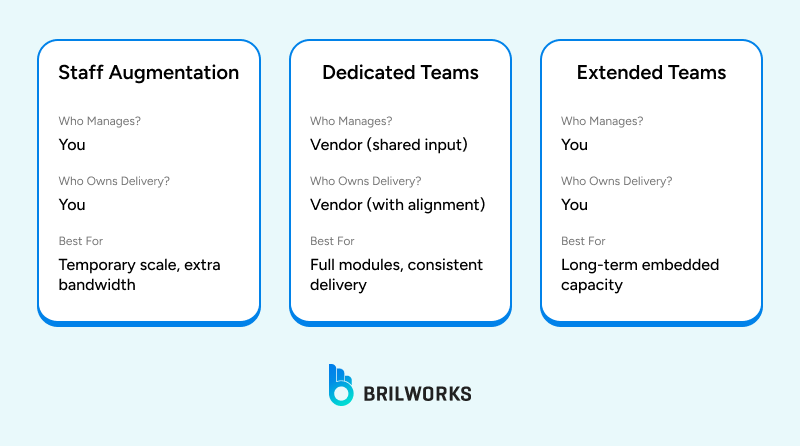
Staff augmentation is the simplest model. You hire individual developers (or designers, testers, analysts) through a vendor, but you manage them as if they were your own employees. You own the roadmap, the stand-ups, the sprint reviews, and the deliverables.
This model is ideal when:
You already have a solid internal engineering team
You need extra hands on a known codebase
You want tight control but don't want to expand headcount
The upside:
Control and flexibility.
The downside:
No delegation of delivery.
Staff augmentation works best when you know exactly what needs to be built and just need capacity, not leadership.
Dedicated teams are not just extra developers. You get a cross-functional group, engineers, leads, QA, and DevOps, that works together under its own internal leadership structure, aligned to your goals.
What makes this model powerful is the blend of commitment and independence. The team is exclusive to you, but you don't micromanage their sprint-by-sprint execution.
Dedicated teams make the most sense when:
You need consistent delivery without scaling your internal org
You're working on large, evolving projects
You want a strategic partner, not just rented capacity
Extended teams sit between the first two. The people are external, but they work inside your environment, in your tools, under your process, for long periods. They don't own delivery, but they become part of your company rhythm. Over time, extended teams become like a part of your in-house staff. You may even bring some of those developers in-house later.
Use this model when:
You're scaling fast but want culture fit and shared process
You need people embedded in your daily workflow
You want to gradually "own" more of your external team over time
Dedicated teams work best during active product build phases, when new features, architecture upgrades, or entire apps are being developed. If you're launching a fintech platform, rebuilding your legacy CMS, or adding an analytics dashboard for users, you want engineers focused solely on that effort, not diluted across internal tasks.
When internal hiring cycles stretch beyond 6–8 weeks, typical in North America and Europe. Dedicated lets you onboard full teams within 2–4 weeks, often including frontend, backend, and QA talent.
This kind of startup-level velocity is especially useful for:
MVP builds and market validation cycles
Time-sensitive client implementations
Expansion into new product lines or verticals
Hiring full-time employees comes with fixed costs: salaries, benefits, hardware, office space, and management bandwidth. When those costs don't match your funding or forecast model, you may onboard a dedicated team. That flexibility is one reason VC-backed startups and bootstrapped SaaS companies often opt for dedicated teams in early and mid-stage growth.
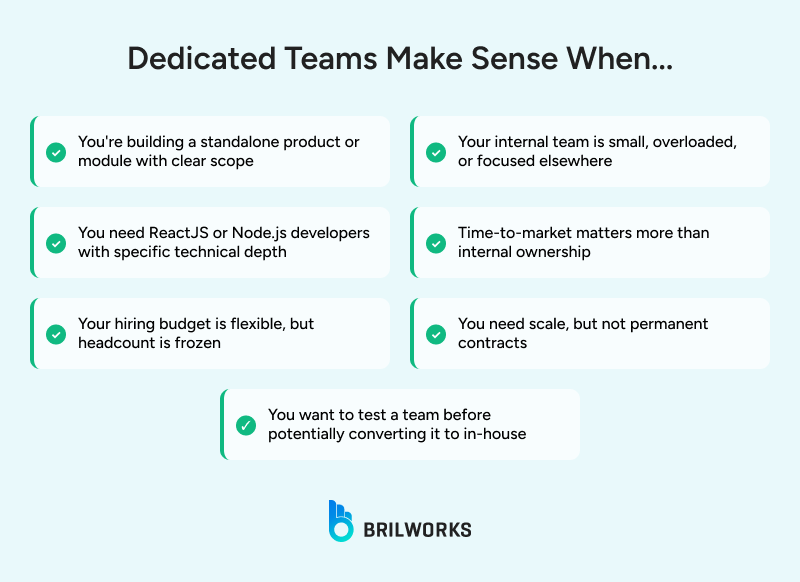
In-house hiring can be a default choice when your product, brand, or internal processes require tight alignment, long-term retention, and full IP control.
If you're working on the infrastructure that defines your business, say a proprietary algorithm or a secure enterprise-grade backend, an in-house setup becomes the default option.
In-house teams typically build stronger informal networks across marketing, sales, customer success, and ops. And if your product is evolving rapidly based on user feedback, it is best served by developers who are working in-house.
In-house hiring is more expensive. But if your funding model supports it, and your roadmap depends on consistent execution over years, not quarters, this investment pays off. Retention becomes a strategic asset.
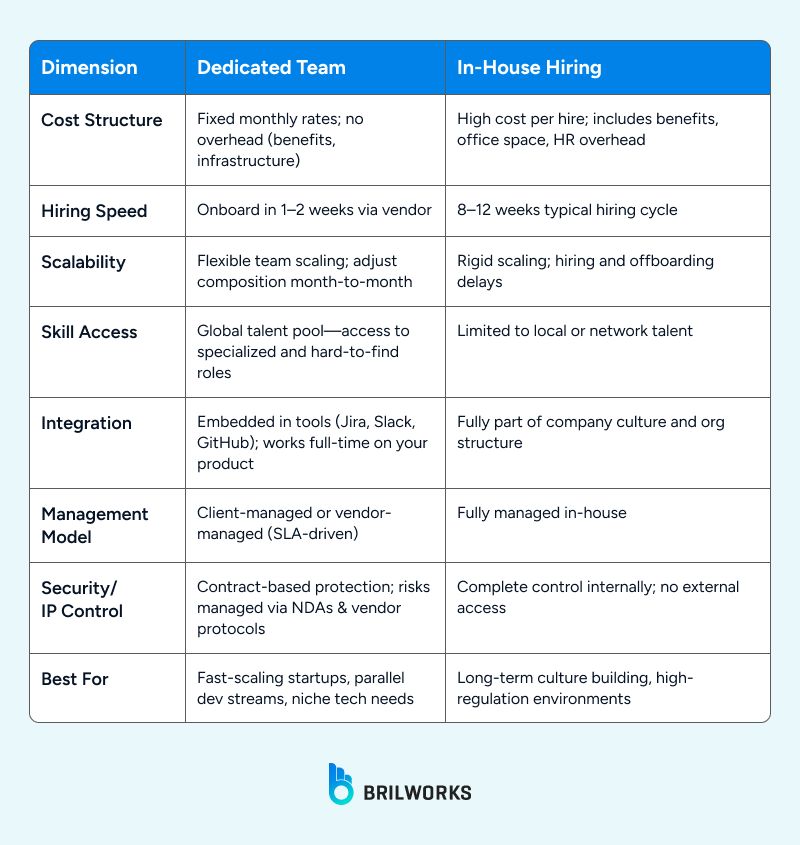
Look at the next 6 to 12 months. Are you launching new features or maintaining legacy systems? Are you scaling to meet demand, or refining existing infrastructure? These answers reveal where speed, specialization, or stability are most needed.
Identify the missing roles, skills, or bandwidth holding back your delivery. This helps determine whether you need temporary support (staff augmentation), a standalone build unit (dedicated team), or long-term internal hires.
Dedicated teams can help you scale faster without long-term payroll liabilities. In-house hiring works better if you're committed to building and retaining strategic knowledge over time.
Many high-performing companies mix models. You might keep product leads, architects, and core IP in-house, while hiring Node.js developers or a ReactJS development squad as a dedicated team to accelerate UI/UX work, API builds, or integrations.
Brilworks helps product-driven companies build and manage dedicated teams that specialize in cloud platforms, AI-powered applications, and scalable web products. For personalized guidance on structuring your development team, contact Brilworks to speak with our technical consultants.
A dedicated team works as a cohesive unit with its own management, focused solely on your project. Staff augmentation adds individual contributors to your existing team under your management.
It eliminates recruitment, onboarding, benefits, office space, and long-term training costs, letting you scale delivery without increasing permanent overhead.
When they need fast access to skilled developers, want to avoid lengthy hiring cycles, or need to deliver a product without long-term hiring commitments.
Vendors use standardized development processes, project management tools, continuous integration pipelines, and QA checks to ensure consistency.
They can deliver specific technical outcomes efficiently, but for strategic decision-making, internal product ownership, and in-house teams are usually better suited.
Get In Touch
Contact us for your software development requirements
Get In Touch
Contact us for your software development requirements